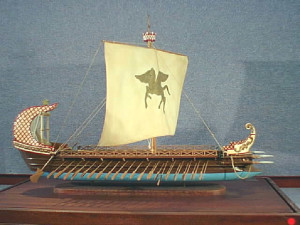The Ship
The Bireme, that is, a ship with two banks of oars per side, marks the first major advance in ship design from the simple oared rowing vessel. Probably developed by the Phoenicians, a century before the Greeks adopted the design in the 8th Century, B.C., the Bireme set the stage for the first real fighting warship. These ships, from 65 feet to 125 feet in length, would have from nine to twenty oars per side. The oarsmen, one to an oar, sat on benches, one above the other in later examples, rather than two or more men to an oar. In the earliest design, the oarsmen would rise to a standing position and then sit as a part of pulling the oar to get the maximum power. This arrangement gave way to the two-level design with one row of oars below the deck level or at the gunwale, and another slightly staggered at the deck level. The staggering of the oarsmen at the deck level thus led to separating the deck and fighting platform from the rowing benches so as to protect the oarsmen in battle.
One of the prime features of these boats was their acceleration capability.
The development of Biremes reflected, or perhaps occurred concurrently, with one other major design improvement in war craft—the fixing of a ram on the bow. The ram was to remain on warships into the 19th Century (being used in the U.S. Civil War), But its effectiveness really came to an end at the Battle of Lepanto (1571) when the galley gave way to the galleon, a sail-powered ship, as the fighting ship.
The Bireme was not itself a major seagoing vessel. Light, and with a narrow beam (usually not exceeding 12 feet), they were essentially day boats used on calm seas in groups as fighting platforms. Each had a small sail to conserve the energy of the oarsmen. They were rowed into battle. Rowing took high energy so their fighting power was limited. At night, they were pulled up on the beach, usually into storehouses prepared for their maintenance. Foundations of these houses still can be found in Greece.
The Model
Scale: 3/16” H 31” L 43” W 25″
Builder unknown
Source: Quester Maritime Collection, Stonington, Connecticut

